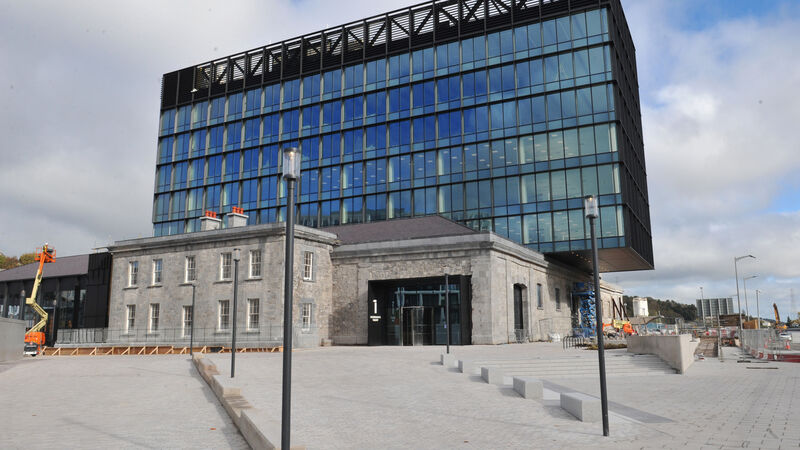Michael Moynihan: Rediscovering the new parts of a reimagined old trading city

Older structures on Horgan's Quay are folded into new, larger buildings like this modern office block 'sitting' on top of the former 'Goods Shed'. Picture: Larry Cummins
Because my research assistants get restless these days, particularly without school to go to, we decided to stroll into town the other day.
Sheath that sword if you’re easily offended. We stayed well within our five-kilometre zone: less of the outrage.
Our destination was a new part of the old city — Horgan’s Quay and environs. This is a zone of interest to yours truly because in a previous life I travelled through this area at least twice a week on the way to Kent Station — on Tuesday mornings for the early train to Dublin and on the late train Thursday evening coming back.
This meant getting familiar with a few nooks and crannies on the way, such as the steps down to the river by that little house on Custom House Quay facing Éamon de Valera Bridge, where I once got into a staring match with a grumpy heron.
I wasn’t that familiar with the nooks and crannies, mind: I was a couple of years into my twice-weekly trips when I realised there was a short cut through the train station car park which cut out the long walk around to the Lower Glanmire Road via Alfred Street. Ah well.
My reason for going back there a couple of days ago was straightforward.
Much as I would love to inform readers it was sparked by a desire to instil in my research assistants a deep and undying love for their city, or to equip them for adventures as urbanists, or even to take up arms against the massed forces of capitalism and bring the system down around our ears, our goal was simple, and sparked by a passing comment from one of them as we’d driven past a while beforehand: "This place would be perfect to practice for the zombie apocalypse."
In this the two of them are their father’s children. Long before Cillian Murphy did all of Cork proud by walking around the eerie, empty streets of London before being set upon by hordes of infected, your columnist had a grisly fascination with the undead.

That’s not the case in 28 Days Later, the movie Cillian appears in, by the way. Those people are infected with a lab-borne virus and are not, strictly speaking, zombies. I am aware that the phrase ‘strictly speaking’ is doing a lot of work in the preceding sentence.
That ‘lab-borne virus’ is not a term any of us now really take lightly. And that my status as a responsible member of society is now imperilled.
That is not the point, though, when the future of humanity at stake, and at present there is nowhere better to simulate that scenario than the Horgan’s Quay zone.
They seem to be putting in a lot of flower areas too which is nice. A decent size plant area around a mature tree on Railway Square outside The Dean, a small landscaped area on Station Square and a big landscaped section lining Horgan’s Quay, not to mention Penrose Dock’s pic.twitter.com/WYcA1RuoMr
— Dylan :) (@DylanCTweets) December 28, 2020
The office blocks are brand new, the footpaths are clean as a whistle. Older structures are folded into new, larger buildings. There are fountains.
However, the emptiness of the narrow connecting streets and walkways are a little eerie. Hence my research assistants’ considered opinion that it should be repurposed while the lockdown is going on.
One said:
"This fountain would be a perfect rallying point once they get into the train station," said the other.
"Don’t be ridiculous, how could the people coming off the train get over here if the exit is cut off?"
Yours truly tried to point out the interesting contrasts in the area — the Horgan’s Quay area was where the train arrived in Cork from the 1850s onwards, for instance, after the original station out in Blackpool was bypassed when the tunnel was opened.
At that time the river quays were in active use for transport, and cattle could be loaded at Horgan’s Quay for export to Britain, for instance.
A closer look at the new Horgan's Quay development. Coming along nicely.
— Sam 🇮🇪🤝🇵🇸 (@Samtm023) December 11, 2020
Lovely lighting in the evenings! pic.twitter.com/POIsckmX58
"Narrow streets like Railway Street probably echoed to the thunder of hooves over the years as those cattle were driven on to the quay," I said, waxing lyrical in order to distract my companions from their discussions about the possibility of clambering into the Carriage Shed if pursued by the infected.
"This is what every city is looking for now," I burbled on, pointing to the clean, sleek lines of glass and concrete that carry an overt message of thrumming efficiency, of business operating fluently behind tinted windows, the flow of information and figures, silent and unseen, passing through the ether.
"Makes quite the contrast with the scene a century and a half ago, roaring cattle clattering down the street, the footpaths and roads smeared with dung, the air heavy with their smell."
One of them looked over at me: "Cattle? Those could come in handy if we were besieged for a while in one of the buildings."
"True," said the other. "Especially with my new Swiss Army knife."
On a serious note, by rights the entire area around the train station should be teeming with people — hotel guests setting out to take in the city, visitors disembarking from the train and heading into town, office workers taking a break for a restoring coffee or a quick cigarette. (Be honest. Did you ever think you’d be nostalgic for the time you could pass someone smoking in the alley behind an office?)
The night skies of beautiful Cork, with views of some of the new developments in the heart of the city, Penrose Dock and Horgan's Quay, and across the @PortofCork and river Lee to the south docks.#WeAreCork @GrowInCork pic.twitter.com/mXoJGoiN9P
— Connecting Cork (@ConnectingCork) December 18, 2020
The downside of a place that new is the absence of association, a blank blandness that needs to be stained by years of events and mishaps and chance meetings. Only through the churn of events and bumps in routine can an area that is literally shiny and new acquire the character we associate with outer parts of the city.
Until then, though, the need to evaluate a zone on its potential to withstand the undead takes precedence. At least it did for my assistants, though I strongly suspect that a lack of outlets offering hyper-sugared hot drinks was a significant driver in their mission to use Horgan’s Quay as preparation for World War Z.
That lack also brought home to me the experience of the child in the pandemic city, by the way.
Having ‘town’ reduced to its essential elements — buildings, windows, roads to cross — underlines its inscrutability for a small child, its inherent hostility to those too young to have the codes which explain how it works.
Eventually we had enough of preparing for the walking dead, and we decided to head off. We were standing out on the quay — it’s Penrose’s Quay, by the way, not Penrose Quay, according to the actual street sign — when one of them pointed across the river to the R & H Hall silos on Kennedy Quay.
That expanse of warehouses and towers and weighbridges — grimy, stained — is a sharp contrast now to the huge, gleaming cubes on Horgan's Quay. Given the gradual growth of the city down towards the harbour mouth, it probably won’t be long until Kennedy Quay begins to mirror the riverbank opposite.
"They’ll be down there soon," I said.
"Are you still talking about zombies?" asked one of my assistants.
"Of course," I said, and we set off home for some hot chocolate.











